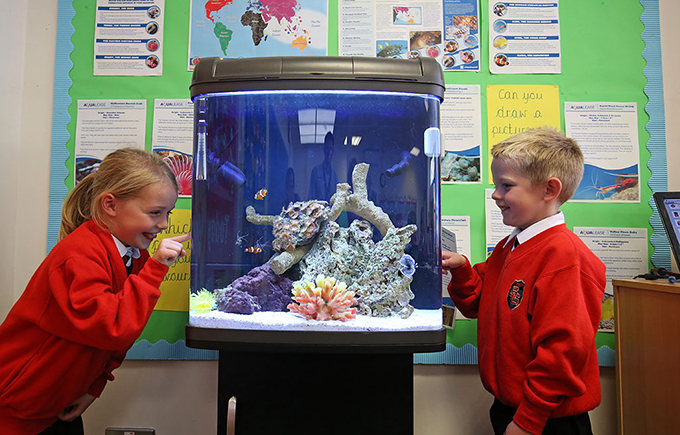
One of the best ways to get children excited about learning is to incorporate hands-on educational projects with their typical reading, writing, and arithmetic assignments. Classroom aquariums have long been a popular option for teaching scientific concepts. Let’s take a look at how you can use classroom aquariums as an educational tool for children of all ages!
Benefits of Educational Aquariums
Aquariums can be used in classroom projects for many purposes, and the goal of an educational aquarium usually varies depending on the age of the children and where they are in their curriculum. Classroom aquariums can be educational on their own or they can also be used to reinforce or practice other lessons.
Classroom Aquariums for Younger Children
One of the first reasons primary school teachers set-up aquariums is to teach their young students about responsibility and caring for others. Many children take pride in their assignment to feed the classroom Betta fish or clean the turtle tank. Having a classroom aquarium can be a powerful tool to motivate kids to do their book work so they can earn the privilege of caring for the class pet.
As children mature and start tackling more complicated topics, an aquarium can become a hands-on learning tool. For instance, when teaching about fractions and percentages, an educator could use the aquarium to demonstrate how to calculate how much water should be removed to perform a 25% water change.
The great thing is you don’t need a complicated or expensive set-up to start a simple classroom Betta or Zebra Danio aquarium. Just get a 5-gallon or larger aquarium, add some gravel or sandy substrate, a simple internal filter, and a heater for your Betta or Danios. If your classroom is sunny you might not even need to buy a light!
Aquariums for Older Students
By the time children reach middle school, they are ready to start learning about more complex concepts, and this is where having a classroom aquarium can really come in handy. Middle schoolers should be encouraged to ask questions as they begin their scientific studies and not just memorize a bunch of facts. Asking questions and then searching for the answers is a key part of developing scientific literacy and is especially important in these post-Covid times.
Understanding the cycle of water and nutrients in an ecosystem can be tough for many young students to picture in their minds, even when shown diagrams in their biology textbooks. Incorporating an aquarium into your ecology lesson plans can help students visualize the process by seeing how it works first-hand. They can even experiment with different set-ups to see what happens if they interrupt the cycle!
In fact, studies show that using aquariums along with traditional lessons can help students master the concepts and vocabulary of inquiry, and these skills even transfer over to other areas of study.
Using Classroom Aquariums as Educational Tools
While they are a popular tool for teaching elementary and middle school students about animal husbandry and biology, you shouldn’t feel limited to using a classroom aquarium for only those subjects. As I mentioned above, an aquarium can be a powerful tool to reinforce other lessons as well, and once you have your classroom tank up and running, why not take advantage of it?
Reading and Writing-Based Aquarium Projects
Aquariums can be a great way to motivate students to improve their reading and writing skills. Students may be asked to write a report on the class pet or give a talk about their preferred habitat and diet. You might have them learn about the class pet’s native country and use that as part of a geography lesson. There’s really no end to the number of ways you could incorporate the class aquarium in your lesson plans!
Math and Chemistry Projects with Aquariums
You can teach more than just fractions and percentages with an aquarium. They are also an ideal way to introduce your students to chemistry and more complicated mathematics! With things like easy-to-use testing strips and pH meters, it’s not hard at all to get middle schoolers excited about basic chemistry when you utilize your classroom aquarium!
I remember learning about the Nitrogen Cycle in my middle school physical science classroom by testing our Betta aquarium’s water every day for a month and tracking the ammonia and nitrate levels. I still have vivid memories of that month-long project, even though I’ve long forgotten the specifics of other lessons.
Educational Aquariums in the Home
Aquariums can be powerful educational tools and a great way to incorporate hands-on learning into a classroom. Many parents have also seen the benefits and started their own education aquariums at home. Whether you’re setting up a classroom tank or one in your home, an aquarium can be a very useful way to get children excited about learning!
